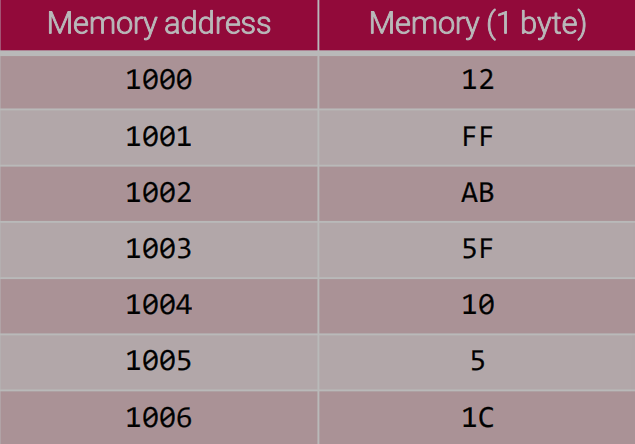[OODP] 2. Compound Types(3)
POSTECH OODP Lecture at 24SS
Compound Types
- Built on basic types.
- Arrays, strings, pointers, structures
Pointers
Variable that holds the address of a value in Linear memory model
Linear memory model은 flat memory model이라고 불리기도 한다.
프로그램 기준에서 memory는 continuous memory addresses를 가진 것처럼 보이기 때문이다. 이것은 실제 physical addresses와는 다르다.

모든 variable은 특정한 메모리 위치에 할당된다. 예를 들어, 4-byte integer는 1000~1003에 할당된다.

이떄 저장되는 방식에는 2가지가 있다. Big endian은 큰 숫자가 먼저 온다. Little endian은 큰 숫자가 나중에 온다.
각 변수의 address는 address operator(&)를 사용해 얻을 수 있다.
// 1000~1003번지
int variable = 0x12345678;
cout << &variable << endl; // 1000
값의 위치를 저장하는 변수인 Pointer의 선언은 다음과 같다. 다만, 보통 type보다는 변수명에 붙여 쓰는 것은 아래 ptr2는 포인터지만, e는 char 변수이기 때문이다.
// typename * pointer_name;
int val;
int *ptr = &val; // pointer to integer initialized to &val
char *ptr2, e; // while ptr2 is a pointer to char, e is a char variable;
좀 더 다양한 예시가 address.cpp에 마련되어 있다.
- Dereferencing Operator(*) : *pointer는 pointer에 저장된 위치에 담긴 값을 기리킨다.
*ptr = 100; // equivalent to 'val = 100;'
cout << *ptr << endl; // 100
cout << val << endl; // 100
val = 500;
cout << *ptr << endl; // 500
cout << val << endl; // 500
- 포인터의 크기는 가리키는 값의 type과 관계 없이 동일하다. 시스템의 memory address의 크기에 의해 결정된다. (32-bit:4GB -> 4, 64-bit:16TB -> 8)
cout << sizeof(char) << ", " << sizeof(char*) << endl; // 1, 8
cout << sizeof(int) << ", " << sizeof(int*) << endl; // 4, 8
cout << sizeof(double) << ", " << sizeof(double*) << endl; // 8, 8
int *ptr1 = (int*)100;
int n1 = 10, m1 = 5;
ptr1 = ptr1 + n1; // ptr = 100 + sizeof(int) * n (4*n bytes) ➔ 140
ptr1 = ptr1 - m1; // ptr = ptr - sizeof(int) * m (4*m bytes) ➔ 120
double *ptr2 = (double*)100;
int n2 = 10, m2 = 5;
ptr2 = ptr2 + n2; // ptr = 100 + sizeof(double) * n (8*n bytes) ➔ 180
ptr2 = ptr2 - m2; // ptr = ptr - sizeof(double) * m (8*m bytes) ➔ 140
- Pointer Arithmetic and Pointer to Array
Pointers are especially useful to handle arrays
double wages[3] = {10000., 20000., 30000. };
short stacks[3] = {3, 2, 1};
// These two statements work the same way
double *pw = wages;
short *ps = &stacks[0];
// These three statements work the same way
cout << stacks[0] << ", " << stacks[1] << endl;
cout << *stacks << ", " << *(stacks + 1) << endl;
cout << *ps << ", " << *(ps+1) << endl;
* name of array = the address of the first element
*(ps+2) = 5; // ps+2 == (the addr in ps) + 2*sizeof(short)
// which is the addr of stacks[2]
ps[2] = 5; // equivalent to *(ps+2) = 5
* pointer arithmetic with dereferencing operator allow to access an element of an array
Strings
A series of characters stored in consecutive bytes of memory
- C-style string: stores a string in an array of char
We can use pointers to strings in the same way as using pointer to array
- string의 끝을 뜻하는 Null-character(‘\0’)을 반드시 넣어줘야함.
- C++에서는 string literals 사이에 whitespace(spaces, tabs, and newlines)만 존재한다면 자동으로 합쳐준다.
- string class library
We can also use string functions of C++ standard libraries using pointers
// Name of char array(animal)은 constant이지만, str은 변수로 인식됨
char animal[5] = "bear"; // animal holds bear
char buff[20];
char *str = animal; // str points to the 1st element of animal
animal = &buf // not allowed : const는 바뀌지 않음
str = &buf // okay
int len1 = strlen(animal);
int len2 = strlen(str);
strcpy(buff, animal);
strcpy(buff, str);
cout << animal << endl;
cout << str << endl;
Questions?
Q1. Pointer에 저장된 값(ptr)는 특정 변수의 주소(&var)이고, Pointer가 역참조 값(*ptr)은 변수의 값(var)이라면, 왜 초기화할 떄 ‘int *ptr = &val;‘라고 쓰는가?
A1. ‘int *ptr = &val;‘은 ‘int *ptr; ptr = &val;‘을 한 줄로 축약하기 위한 약속이다.
Q2. 그런데 왜 ‘역참조’라는 명칭을 쓰는 건가?
A2. 참조라는 용어는 현재 상태에 대한 근거가 외부에 있을 때 사용한다. dereferencing operator(*)는 현재 메모리에 담긴 값을 가리키는 연산자다. ‘변수값(상태)’이 ‘메모리 위치(근거)’를 참조하는 것과 반대로, 메모리 위치에서 변수값을 가져오는 역참조 과정을 수행한다.
